Strategic Information System: Rainbow Illusion Report 2022
VerifiedAdded on 2022/09/22
|14
|3085
|20
AI Summary
Contribute Materials
Your contribution can guide someone’s learning journey. Share your
documents today.
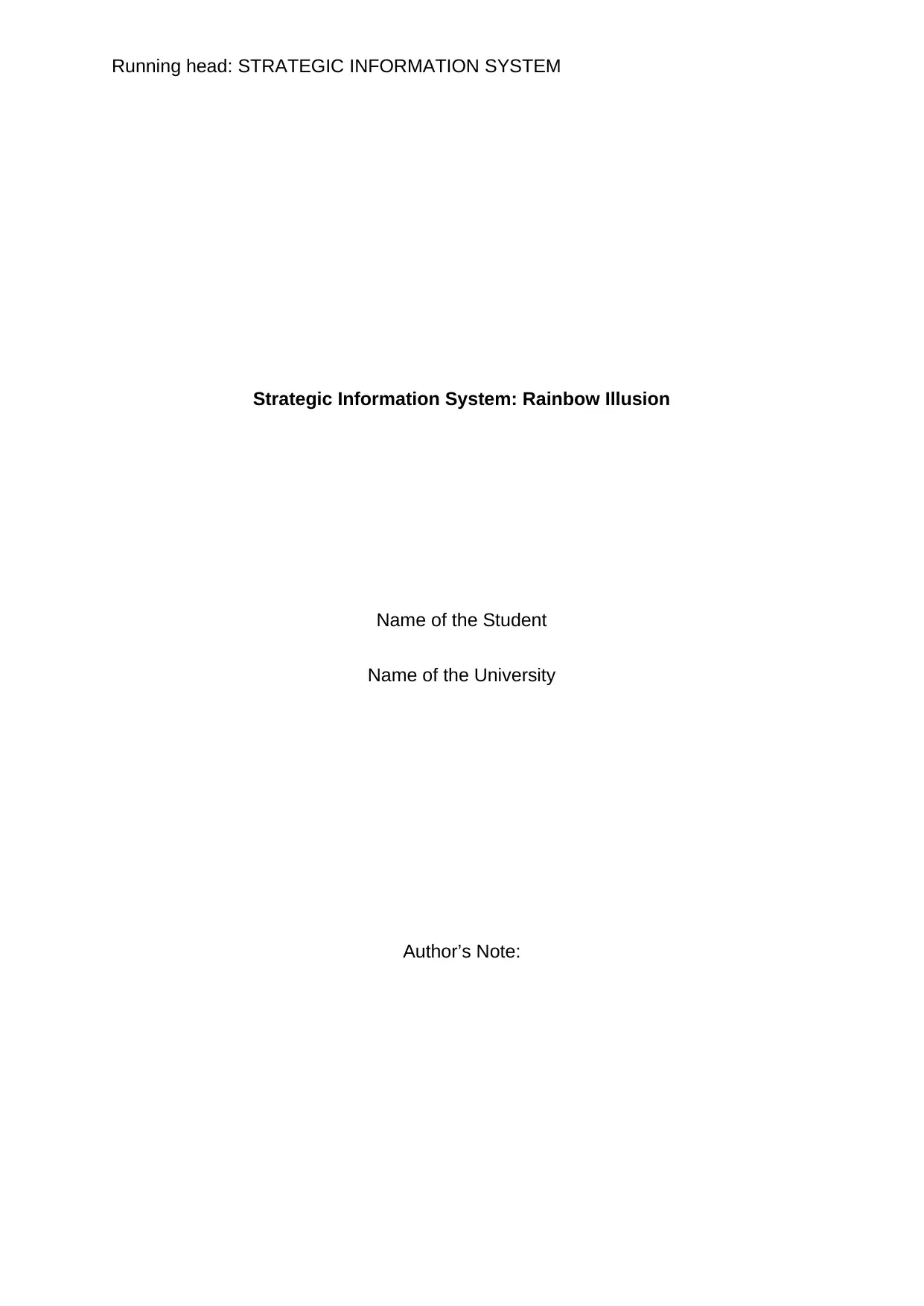
Running head: STRATEGIC INFORMATION SYSTEM
Strategic Information System: Rainbow Illusion
Name of the Student
Name of the University
Author’s Note:
Strategic Information System: Rainbow Illusion
Name of the Student
Name of the University
Author’s Note:
Secure Best Marks with AI Grader
Need help grading? Try our AI Grader for instant feedback on your assignments.
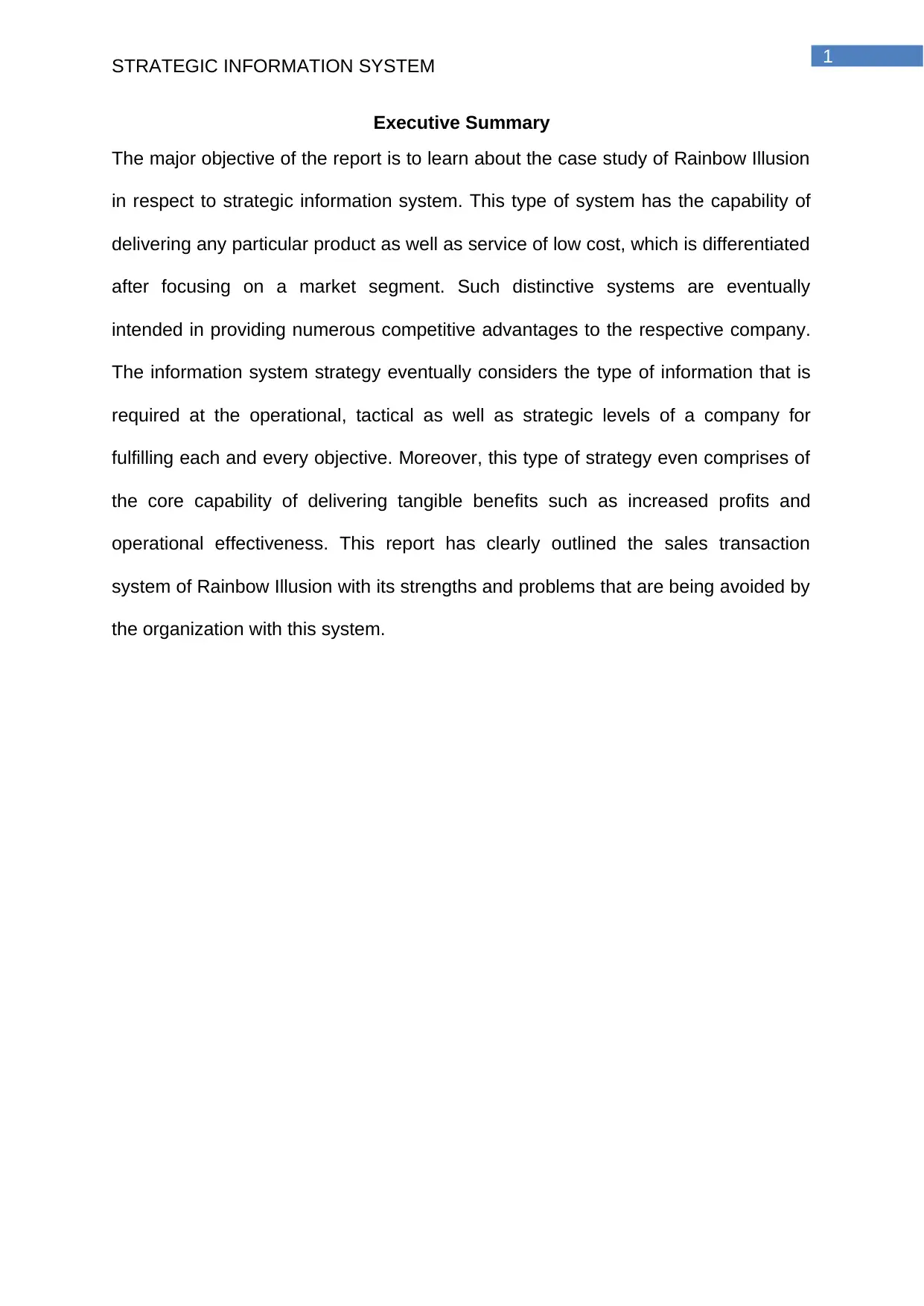
1
STRATEGIC INFORMATION SYSTEM
Executive Summary
The major objective of the report is to learn about the case study of Rainbow Illusion
in respect to strategic information system. This type of system has the capability of
delivering any particular product as well as service of low cost, which is differentiated
after focusing on a market segment. Such distinctive systems are eventually
intended in providing numerous competitive advantages to the respective company.
The information system strategy eventually considers the type of information that is
required at the operational, tactical as well as strategic levels of a company for
fulfilling each and every objective. Moreover, this type of strategy even comprises of
the core capability of delivering tangible benefits such as increased profits and
operational effectiveness. This report has clearly outlined the sales transaction
system of Rainbow Illusion with its strengths and problems that are being avoided by
the organization with this system.
STRATEGIC INFORMATION SYSTEM
Executive Summary
The major objective of the report is to learn about the case study of Rainbow Illusion
in respect to strategic information system. This type of system has the capability of
delivering any particular product as well as service of low cost, which is differentiated
after focusing on a market segment. Such distinctive systems are eventually
intended in providing numerous competitive advantages to the respective company.
The information system strategy eventually considers the type of information that is
required at the operational, tactical as well as strategic levels of a company for
fulfilling each and every objective. Moreover, this type of strategy even comprises of
the core capability of delivering tangible benefits such as increased profits and
operational effectiveness. This report has clearly outlined the sales transaction
system of Rainbow Illusion with its strengths and problems that are being avoided by
the organization with this system.
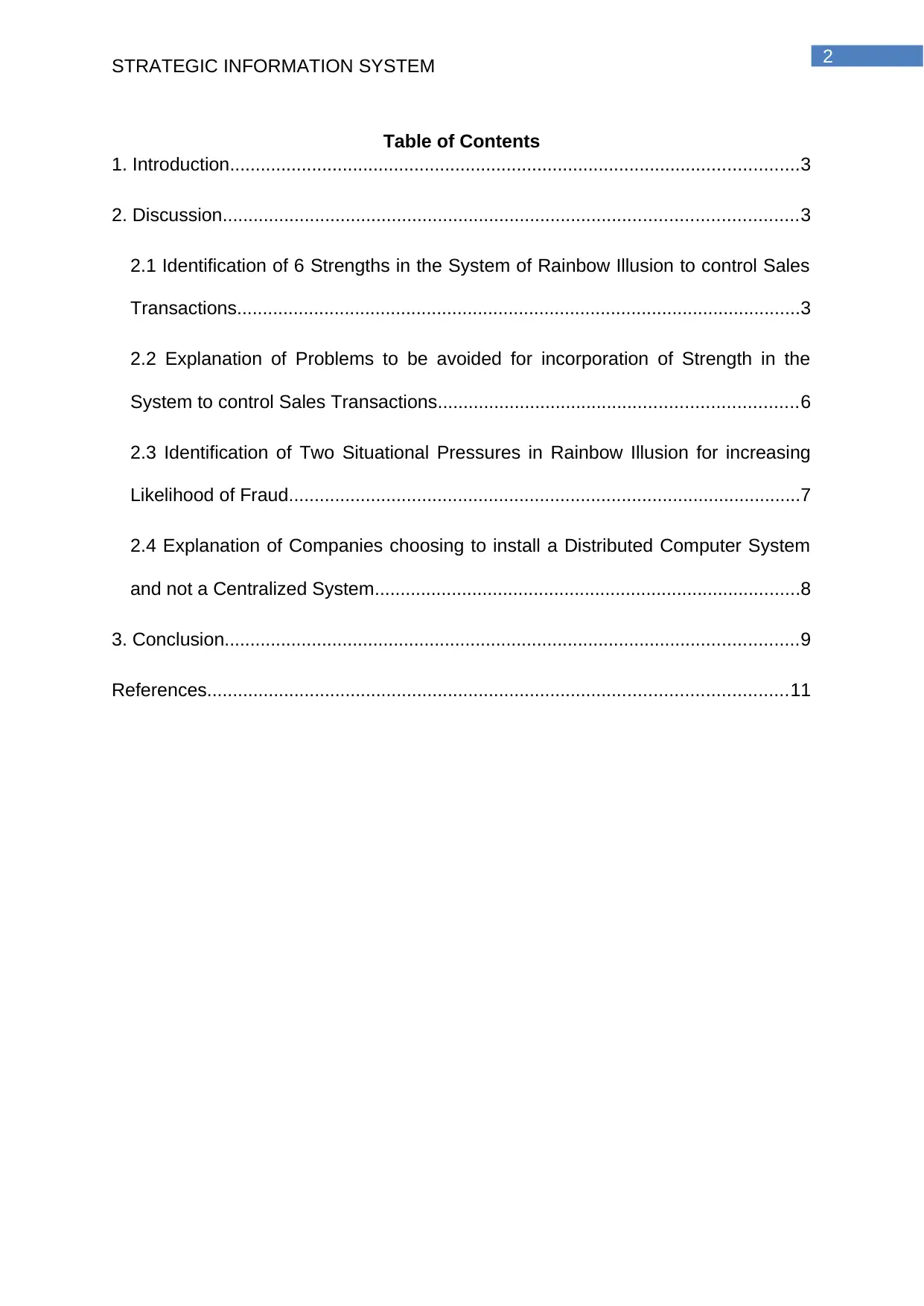
2
STRATEGIC INFORMATION SYSTEM
Table of Contents
1. Introduction...............................................................................................................3
2. Discussion................................................................................................................3
2.1 Identification of 6 Strengths in the System of Rainbow Illusion to control Sales
Transactions..............................................................................................................3
2.2 Explanation of Problems to be avoided for incorporation of Strength in the
System to control Sales Transactions......................................................................6
2.3 Identification of Two Situational Pressures in Rainbow Illusion for increasing
Likelihood of Fraud....................................................................................................7
2.4 Explanation of Companies choosing to install a Distributed Computer System
and not a Centralized System...................................................................................8
3. Conclusion................................................................................................................9
References.................................................................................................................11
STRATEGIC INFORMATION SYSTEM
Table of Contents
1. Introduction...............................................................................................................3
2. Discussion................................................................................................................3
2.1 Identification of 6 Strengths in the System of Rainbow Illusion to control Sales
Transactions..............................................................................................................3
2.2 Explanation of Problems to be avoided for incorporation of Strength in the
System to control Sales Transactions......................................................................6
2.3 Identification of Two Situational Pressures in Rainbow Illusion for increasing
Likelihood of Fraud....................................................................................................7
2.4 Explanation of Companies choosing to install a Distributed Computer System
and not a Centralized System...................................................................................8
3. Conclusion................................................................................................................9
References.................................................................................................................11
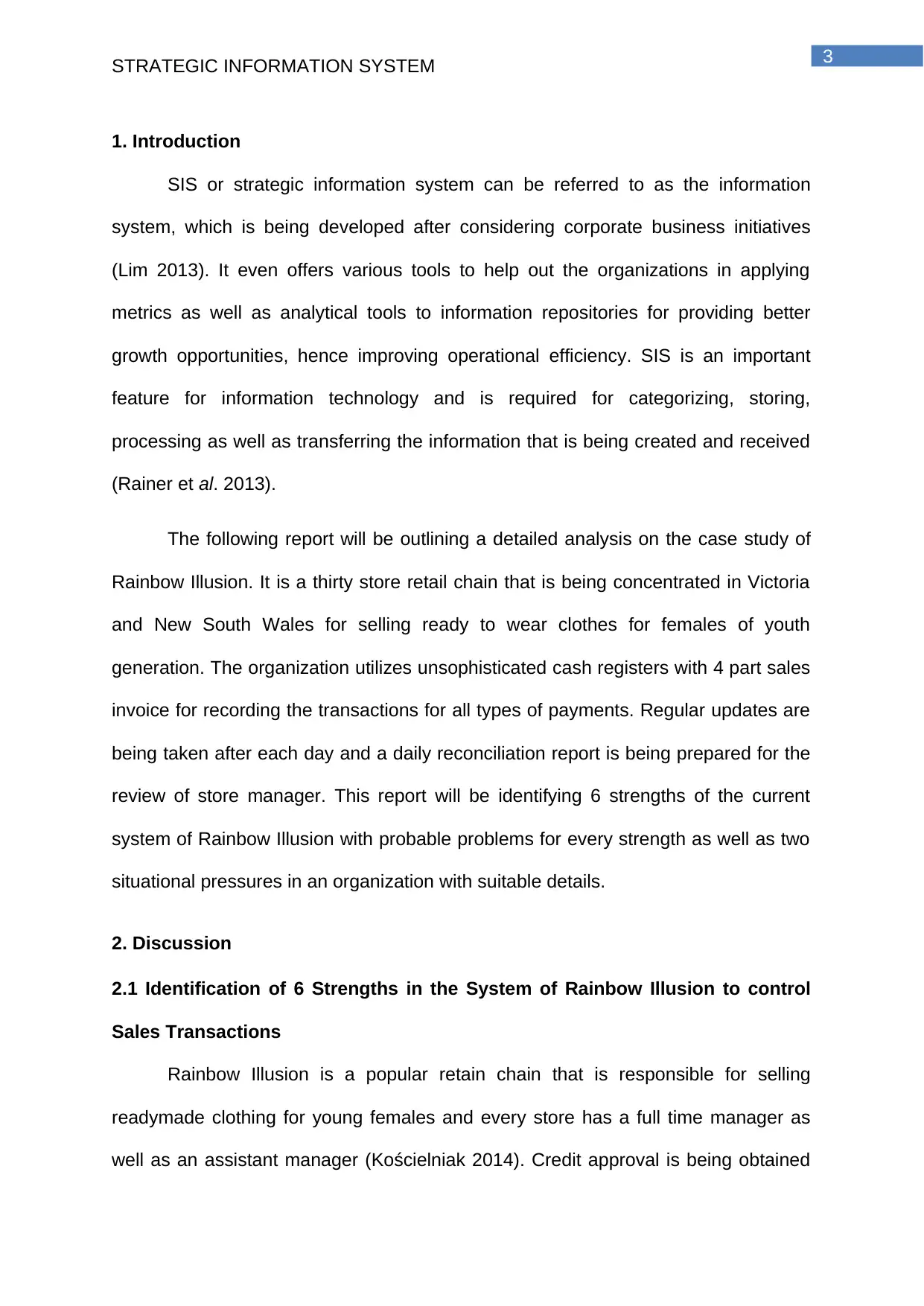
3
STRATEGIC INFORMATION SYSTEM
1. Introduction
SIS or strategic information system can be referred to as the information
system, which is being developed after considering corporate business initiatives
(Lim 2013). It even offers various tools to help out the organizations in applying
metrics as well as analytical tools to information repositories for providing better
growth opportunities, hence improving operational efficiency. SIS is an important
feature for information technology and is required for categorizing, storing,
processing as well as transferring the information that is being created and received
(Rainer et al. 2013).
The following report will be outlining a detailed analysis on the case study of
Rainbow Illusion. It is a thirty store retail chain that is being concentrated in Victoria
and New South Wales for selling ready to wear clothes for females of youth
generation. The organization utilizes unsophisticated cash registers with 4 part sales
invoice for recording the transactions for all types of payments. Regular updates are
being taken after each day and a daily reconciliation report is being prepared for the
review of store manager. This report will be identifying 6 strengths of the current
system of Rainbow Illusion with probable problems for every strength as well as two
situational pressures in an organization with suitable details.
2. Discussion
2.1 Identification of 6 Strengths in the System of Rainbow Illusion to control
Sales Transactions
Rainbow Illusion is a popular retain chain that is responsible for selling
readymade clothing for young females and every store has a full time manager as
well as an assistant manager (Kościelniak 2014). Credit approval is being obtained
STRATEGIC INFORMATION SYSTEM
1. Introduction
SIS or strategic information system can be referred to as the information
system, which is being developed after considering corporate business initiatives
(Lim 2013). It even offers various tools to help out the organizations in applying
metrics as well as analytical tools to information repositories for providing better
growth opportunities, hence improving operational efficiency. SIS is an important
feature for information technology and is required for categorizing, storing,
processing as well as transferring the information that is being created and received
(Rainer et al. 2013).
The following report will be outlining a detailed analysis on the case study of
Rainbow Illusion. It is a thirty store retail chain that is being concentrated in Victoria
and New South Wales for selling ready to wear clothes for females of youth
generation. The organization utilizes unsophisticated cash registers with 4 part sales
invoice for recording the transactions for all types of payments. Regular updates are
being taken after each day and a daily reconciliation report is being prepared for the
review of store manager. This report will be identifying 6 strengths of the current
system of Rainbow Illusion with probable problems for every strength as well as two
situational pressures in an organization with suitable details.
2. Discussion
2.1 Identification of 6 Strengths in the System of Rainbow Illusion to control
Sales Transactions
Rainbow Illusion is a popular retain chain that is responsible for selling
readymade clothing for young females and every store has a full time manager as
well as an assistant manager (Kościelniak 2014). Credit approval is being obtained
Secure Best Marks with AI Grader
Need help grading? Try our AI Grader for instant feedback on your assignments.
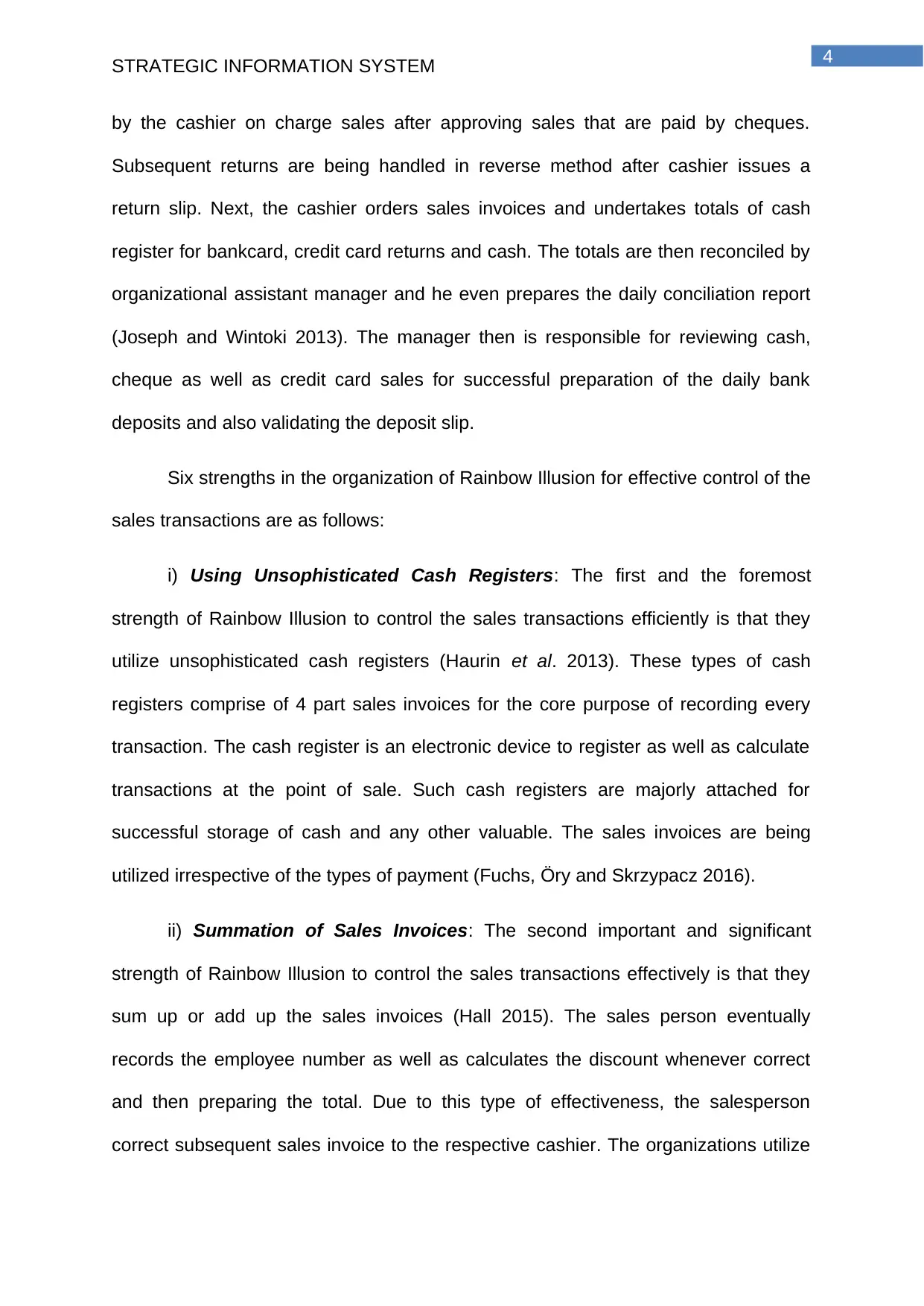
4
STRATEGIC INFORMATION SYSTEM
by the cashier on charge sales after approving sales that are paid by cheques.
Subsequent returns are being handled in reverse method after cashier issues a
return slip. Next, the cashier orders sales invoices and undertakes totals of cash
register for bankcard, credit card returns and cash. The totals are then reconciled by
organizational assistant manager and he even prepares the daily conciliation report
(Joseph and Wintoki 2013). The manager then is responsible for reviewing cash,
cheque as well as credit card sales for successful preparation of the daily bank
deposits and also validating the deposit slip.
Six strengths in the organization of Rainbow Illusion for effective control of the
sales transactions are as follows:
i) Using Unsophisticated Cash Registers: The first and the foremost
strength of Rainbow Illusion to control the sales transactions efficiently is that they
utilize unsophisticated cash registers (Haurin et al. 2013). These types of cash
registers comprise of 4 part sales invoices for the core purpose of recording every
transaction. The cash register is an electronic device to register as well as calculate
transactions at the point of sale. Such cash registers are majorly attached for
successful storage of cash and any other valuable. The sales invoices are being
utilized irrespective of the types of payment (Fuchs, Öry and Skrzypacz 2016).
ii) Summation of Sales Invoices: The second important and significant
strength of Rainbow Illusion to control the sales transactions effectively is that they
sum up or add up the sales invoices (Hall 2015). The sales person eventually
records the employee number as well as calculates the discount whenever correct
and then preparing the total. Due to this type of effectiveness, the salesperson
correct subsequent sales invoice to the respective cashier. The organizations utilize
STRATEGIC INFORMATION SYSTEM
by the cashier on charge sales after approving sales that are paid by cheques.
Subsequent returns are being handled in reverse method after cashier issues a
return slip. Next, the cashier orders sales invoices and undertakes totals of cash
register for bankcard, credit card returns and cash. The totals are then reconciled by
organizational assistant manager and he even prepares the daily conciliation report
(Joseph and Wintoki 2013). The manager then is responsible for reviewing cash,
cheque as well as credit card sales for successful preparation of the daily bank
deposits and also validating the deposit slip.
Six strengths in the organization of Rainbow Illusion for effective control of the
sales transactions are as follows:
i) Using Unsophisticated Cash Registers: The first and the foremost
strength of Rainbow Illusion to control the sales transactions efficiently is that they
utilize unsophisticated cash registers (Haurin et al. 2013). These types of cash
registers comprise of 4 part sales invoices for the core purpose of recording every
transaction. The cash register is an electronic device to register as well as calculate
transactions at the point of sale. Such cash registers are majorly attached for
successful storage of cash and any other valuable. The sales invoices are being
utilized irrespective of the types of payment (Fuchs, Öry and Skrzypacz 2016).
ii) Summation of Sales Invoices: The second important and significant
strength of Rainbow Illusion to control the sales transactions effectively is that they
sum up or add up the sales invoices (Hall 2015). The sales person eventually
records the employee number as well as calculates the discount whenever correct
and then preparing the total. Due to this type of effectiveness, the salesperson
correct subsequent sales invoice to the respective cashier. The organizations utilize
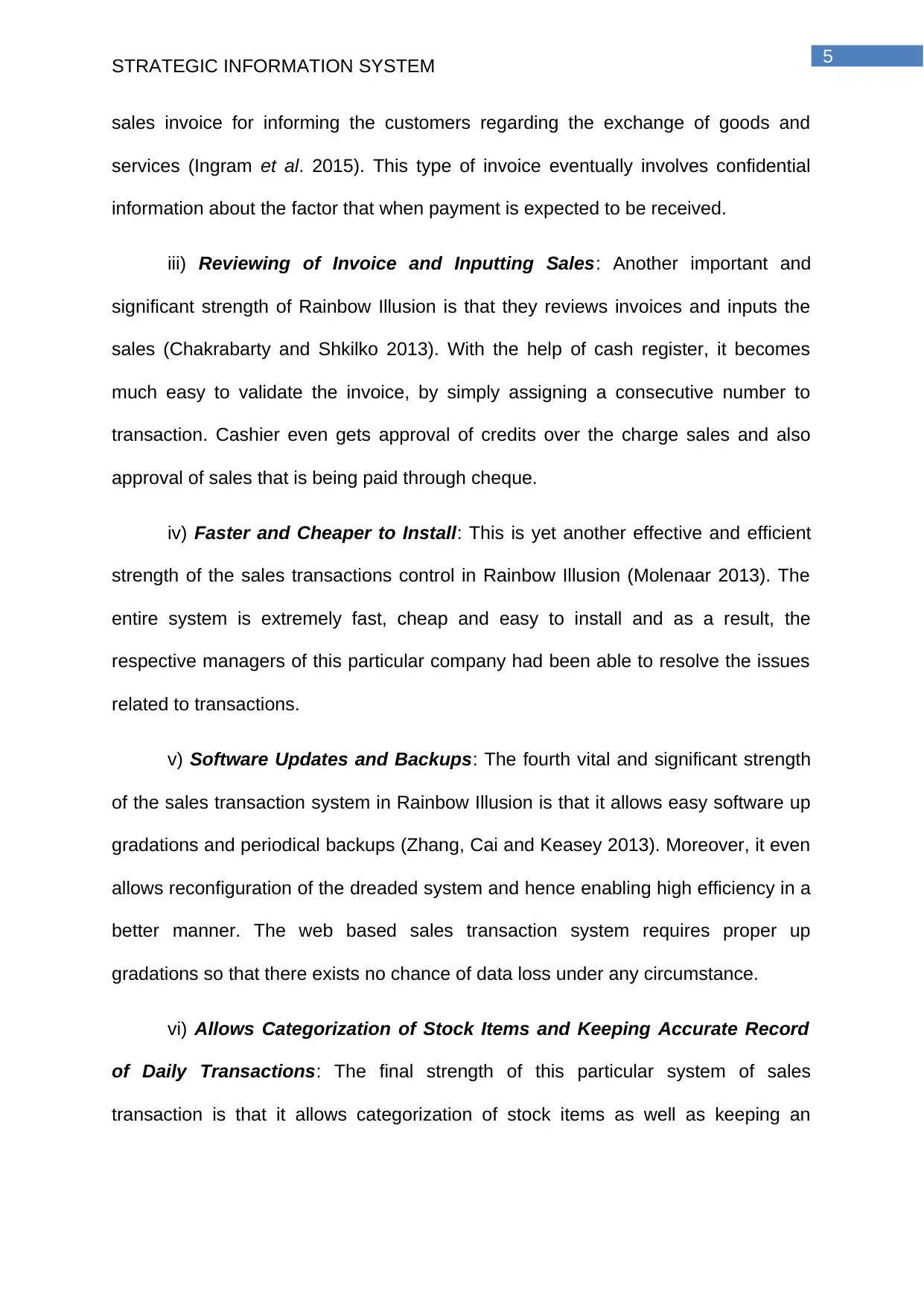
5
STRATEGIC INFORMATION SYSTEM
sales invoice for informing the customers regarding the exchange of goods and
services (Ingram et al. 2015). This type of invoice eventually involves confidential
information about the factor that when payment is expected to be received.
iii) Reviewing of Invoice and Inputting Sales: Another important and
significant strength of Rainbow Illusion is that they reviews invoices and inputs the
sales (Chakrabarty and Shkilko 2013). With the help of cash register, it becomes
much easy to validate the invoice, by simply assigning a consecutive number to
transaction. Cashier even gets approval of credits over the charge sales and also
approval of sales that is being paid through cheque.
iv) Faster and Cheaper to Install: This is yet another effective and efficient
strength of the sales transactions control in Rainbow Illusion (Molenaar 2013). The
entire system is extremely fast, cheap and easy to install and as a result, the
respective managers of this particular company had been able to resolve the issues
related to transactions.
v) Software Updates and Backups: The fourth vital and significant strength
of the sales transaction system in Rainbow Illusion is that it allows easy software up
gradations and periodical backups (Zhang, Cai and Keasey 2013). Moreover, it even
allows reconfiguration of the dreaded system and hence enabling high efficiency in a
better manner. The web based sales transaction system requires proper up
gradations so that there exists no chance of data loss under any circumstance.
vi) Allows Categorization of Stock Items and Keeping Accurate Record
of Daily Transactions: The final strength of this particular system of sales
transaction is that it allows categorization of stock items as well as keeping an
STRATEGIC INFORMATION SYSTEM
sales invoice for informing the customers regarding the exchange of goods and
services (Ingram et al. 2015). This type of invoice eventually involves confidential
information about the factor that when payment is expected to be received.
iii) Reviewing of Invoice and Inputting Sales: Another important and
significant strength of Rainbow Illusion is that they reviews invoices and inputs the
sales (Chakrabarty and Shkilko 2013). With the help of cash register, it becomes
much easy to validate the invoice, by simply assigning a consecutive number to
transaction. Cashier even gets approval of credits over the charge sales and also
approval of sales that is being paid through cheque.
iv) Faster and Cheaper to Install: This is yet another effective and efficient
strength of the sales transactions control in Rainbow Illusion (Molenaar 2013). The
entire system is extremely fast, cheap and easy to install and as a result, the
respective managers of this particular company had been able to resolve the issues
related to transactions.
v) Software Updates and Backups: The fourth vital and significant strength
of the sales transaction system in Rainbow Illusion is that it allows easy software up
gradations and periodical backups (Zhang, Cai and Keasey 2013). Moreover, it even
allows reconfiguration of the dreaded system and hence enabling high efficiency in a
better manner. The web based sales transaction system requires proper up
gradations so that there exists no chance of data loss under any circumstance.
vi) Allows Categorization of Stock Items and Keeping Accurate Record
of Daily Transactions: The final strength of this particular system of sales
transaction is that it allows categorization of stock items as well as keeping an
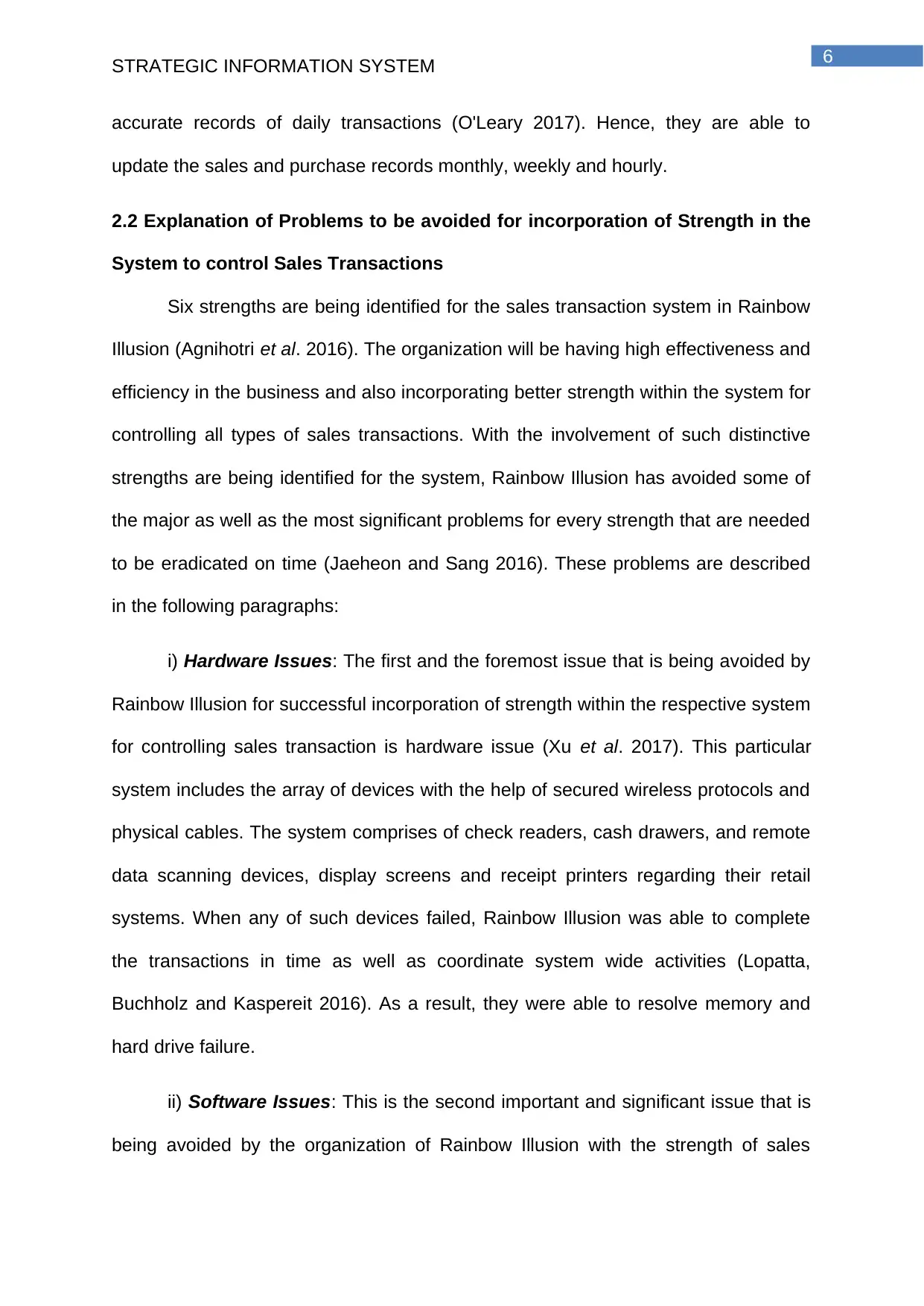
6
STRATEGIC INFORMATION SYSTEM
accurate records of daily transactions (O'Leary 2017). Hence, they are able to
update the sales and purchase records monthly, weekly and hourly.
2.2 Explanation of Problems to be avoided for incorporation of Strength in the
System to control Sales Transactions
Six strengths are being identified for the sales transaction system in Rainbow
Illusion (Agnihotri et al. 2016). The organization will be having high effectiveness and
efficiency in the business and also incorporating better strength within the system for
controlling all types of sales transactions. With the involvement of such distinctive
strengths are being identified for the system, Rainbow Illusion has avoided some of
the major as well as the most significant problems for every strength that are needed
to be eradicated on time (Jaeheon and Sang 2016). These problems are described
in the following paragraphs:
i) Hardware Issues: The first and the foremost issue that is being avoided by
Rainbow Illusion for successful incorporation of strength within the respective system
for controlling sales transaction is hardware issue (Xu et al. 2017). This particular
system includes the array of devices with the help of secured wireless protocols and
physical cables. The system comprises of check readers, cash drawers, and remote
data scanning devices, display screens and receipt printers regarding their retail
systems. When any of such devices failed, Rainbow Illusion was able to complete
the transactions in time as well as coordinate system wide activities (Lopatta,
Buchholz and Kaspereit 2016). As a result, they were able to resolve memory and
hard drive failure.
ii) Software Issues: This is the second important and significant issue that is
being avoided by the organization of Rainbow Illusion with the strength of sales
STRATEGIC INFORMATION SYSTEM
accurate records of daily transactions (O'Leary 2017). Hence, they are able to
update the sales and purchase records monthly, weekly and hourly.
2.2 Explanation of Problems to be avoided for incorporation of Strength in the
System to control Sales Transactions
Six strengths are being identified for the sales transaction system in Rainbow
Illusion (Agnihotri et al. 2016). The organization will be having high effectiveness and
efficiency in the business and also incorporating better strength within the system for
controlling all types of sales transactions. With the involvement of such distinctive
strengths are being identified for the system, Rainbow Illusion has avoided some of
the major as well as the most significant problems for every strength that are needed
to be eradicated on time (Jaeheon and Sang 2016). These problems are described
in the following paragraphs:
i) Hardware Issues: The first and the foremost issue that is being avoided by
Rainbow Illusion for successful incorporation of strength within the respective system
for controlling sales transaction is hardware issue (Xu et al. 2017). This particular
system includes the array of devices with the help of secured wireless protocols and
physical cables. The system comprises of check readers, cash drawers, and remote
data scanning devices, display screens and receipt printers regarding their retail
systems. When any of such devices failed, Rainbow Illusion was able to complete
the transactions in time as well as coordinate system wide activities (Lopatta,
Buchholz and Kaspereit 2016). As a result, they were able to resolve memory and
hard drive failure.
ii) Software Issues: This is the second important and significant issue that is
being avoided by the organization of Rainbow Illusion with the strength of sales
Paraphrase This Document
Need a fresh take? Get an instant paraphrase of this document with our AI Paraphraser
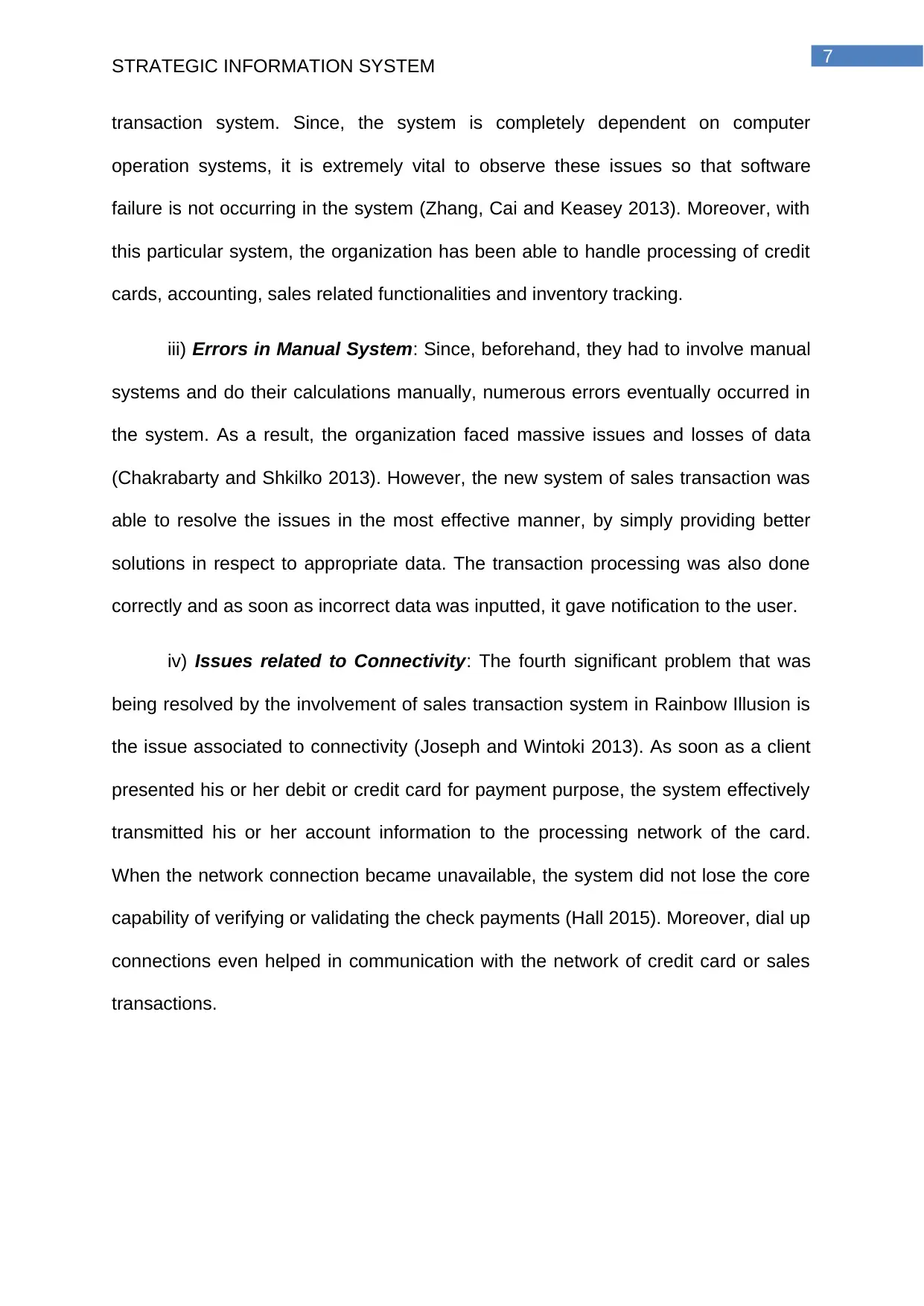
7
STRATEGIC INFORMATION SYSTEM
transaction system. Since, the system is completely dependent on computer
operation systems, it is extremely vital to observe these issues so that software
failure is not occurring in the system (Zhang, Cai and Keasey 2013). Moreover, with
this particular system, the organization has been able to handle processing of credit
cards, accounting, sales related functionalities and inventory tracking.
iii) Errors in Manual System: Since, beforehand, they had to involve manual
systems and do their calculations manually, numerous errors eventually occurred in
the system. As a result, the organization faced massive issues and losses of data
(Chakrabarty and Shkilko 2013). However, the new system of sales transaction was
able to resolve the issues in the most effective manner, by simply providing better
solutions in respect to appropriate data. The transaction processing was also done
correctly and as soon as incorrect data was inputted, it gave notification to the user.
iv) Issues related to Connectivity: The fourth significant problem that was
being resolved by the involvement of sales transaction system in Rainbow Illusion is
the issue associated to connectivity (Joseph and Wintoki 2013). As soon as a client
presented his or her debit or credit card for payment purpose, the system effectively
transmitted his or her account information to the processing network of the card.
When the network connection became unavailable, the system did not lose the core
capability of verifying or validating the check payments (Hall 2015). Moreover, dial up
connections even helped in communication with the network of credit card or sales
transactions.
STRATEGIC INFORMATION SYSTEM
transaction system. Since, the system is completely dependent on computer
operation systems, it is extremely vital to observe these issues so that software
failure is not occurring in the system (Zhang, Cai and Keasey 2013). Moreover, with
this particular system, the organization has been able to handle processing of credit
cards, accounting, sales related functionalities and inventory tracking.
iii) Errors in Manual System: Since, beforehand, they had to involve manual
systems and do their calculations manually, numerous errors eventually occurred in
the system. As a result, the organization faced massive issues and losses of data
(Chakrabarty and Shkilko 2013). However, the new system of sales transaction was
able to resolve the issues in the most effective manner, by simply providing better
solutions in respect to appropriate data. The transaction processing was also done
correctly and as soon as incorrect data was inputted, it gave notification to the user.
iv) Issues related to Connectivity: The fourth significant problem that was
being resolved by the involvement of sales transaction system in Rainbow Illusion is
the issue associated to connectivity (Joseph and Wintoki 2013). As soon as a client
presented his or her debit or credit card for payment purpose, the system effectively
transmitted his or her account information to the processing network of the card.
When the network connection became unavailable, the system did not lose the core
capability of verifying or validating the check payments (Hall 2015). Moreover, dial up
connections even helped in communication with the network of credit card or sales
transactions.
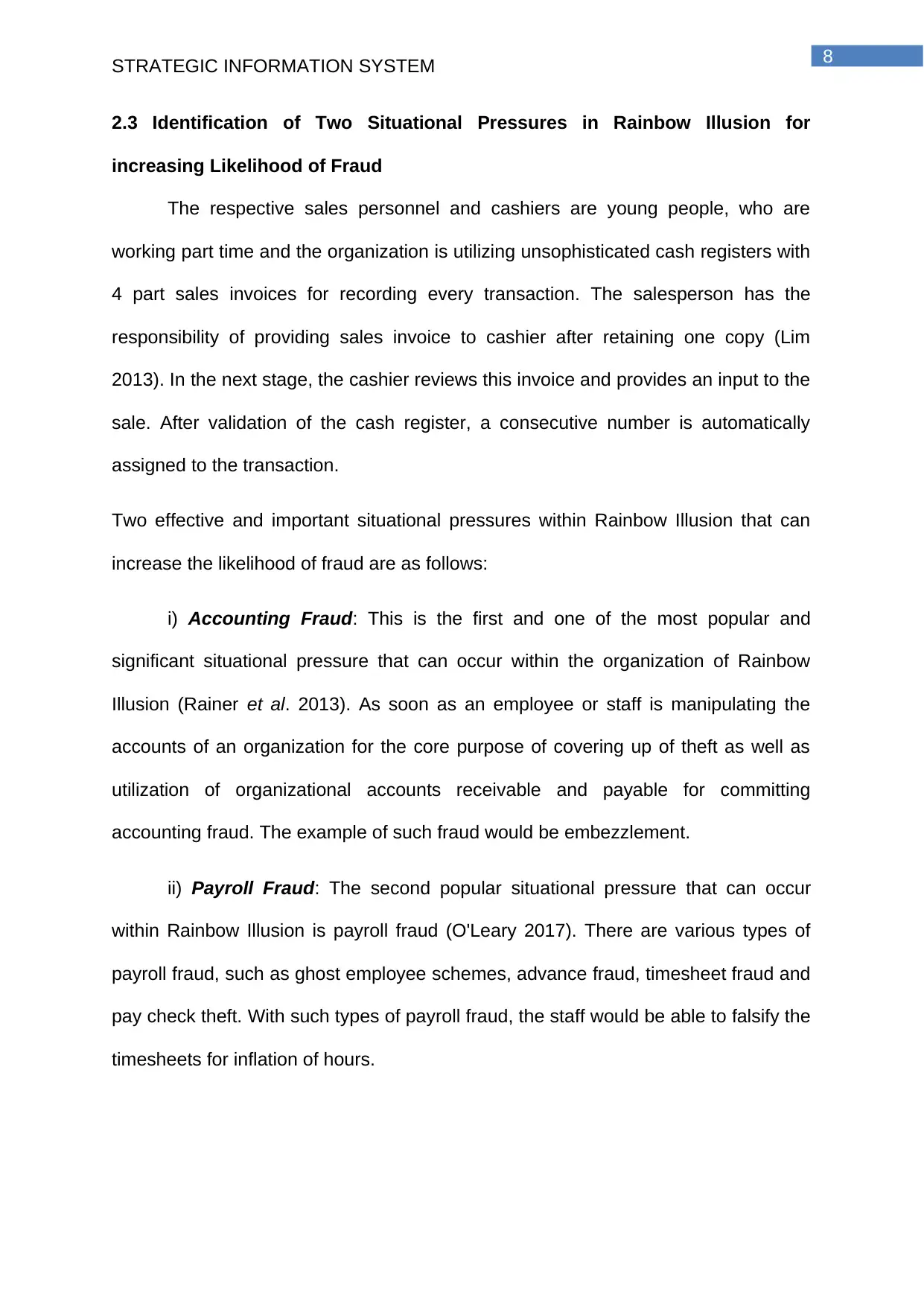
8
STRATEGIC INFORMATION SYSTEM
2.3 Identification of Two Situational Pressures in Rainbow Illusion for
increasing Likelihood of Fraud
The respective sales personnel and cashiers are young people, who are
working part time and the organization is utilizing unsophisticated cash registers with
4 part sales invoices for recording every transaction. The salesperson has the
responsibility of providing sales invoice to cashier after retaining one copy (Lim
2013). In the next stage, the cashier reviews this invoice and provides an input to the
sale. After validation of the cash register, a consecutive number is automatically
assigned to the transaction.
Two effective and important situational pressures within Rainbow Illusion that can
increase the likelihood of fraud are as follows:
i) Accounting Fraud: This is the first and one of the most popular and
significant situational pressure that can occur within the organization of Rainbow
Illusion (Rainer et al. 2013). As soon as an employee or staff is manipulating the
accounts of an organization for the core purpose of covering up of theft as well as
utilization of organizational accounts receivable and payable for committing
accounting fraud. The example of such fraud would be embezzlement.
ii) Payroll Fraud: The second popular situational pressure that can occur
within Rainbow Illusion is payroll fraud (O'Leary 2017). There are various types of
payroll fraud, such as ghost employee schemes, advance fraud, timesheet fraud and
pay check theft. With such types of payroll fraud, the staff would be able to falsify the
timesheets for inflation of hours.
STRATEGIC INFORMATION SYSTEM
2.3 Identification of Two Situational Pressures in Rainbow Illusion for
increasing Likelihood of Fraud
The respective sales personnel and cashiers are young people, who are
working part time and the organization is utilizing unsophisticated cash registers with
4 part sales invoices for recording every transaction. The salesperson has the
responsibility of providing sales invoice to cashier after retaining one copy (Lim
2013). In the next stage, the cashier reviews this invoice and provides an input to the
sale. After validation of the cash register, a consecutive number is automatically
assigned to the transaction.
Two effective and important situational pressures within Rainbow Illusion that can
increase the likelihood of fraud are as follows:
i) Accounting Fraud: This is the first and one of the most popular and
significant situational pressure that can occur within the organization of Rainbow
Illusion (Rainer et al. 2013). As soon as an employee or staff is manipulating the
accounts of an organization for the core purpose of covering up of theft as well as
utilization of organizational accounts receivable and payable for committing
accounting fraud. The example of such fraud would be embezzlement.
ii) Payroll Fraud: The second popular situational pressure that can occur
within Rainbow Illusion is payroll fraud (O'Leary 2017). There are various types of
payroll fraud, such as ghost employee schemes, advance fraud, timesheet fraud and
pay check theft. With such types of payroll fraud, the staff would be able to falsify the
timesheets for inflation of hours.
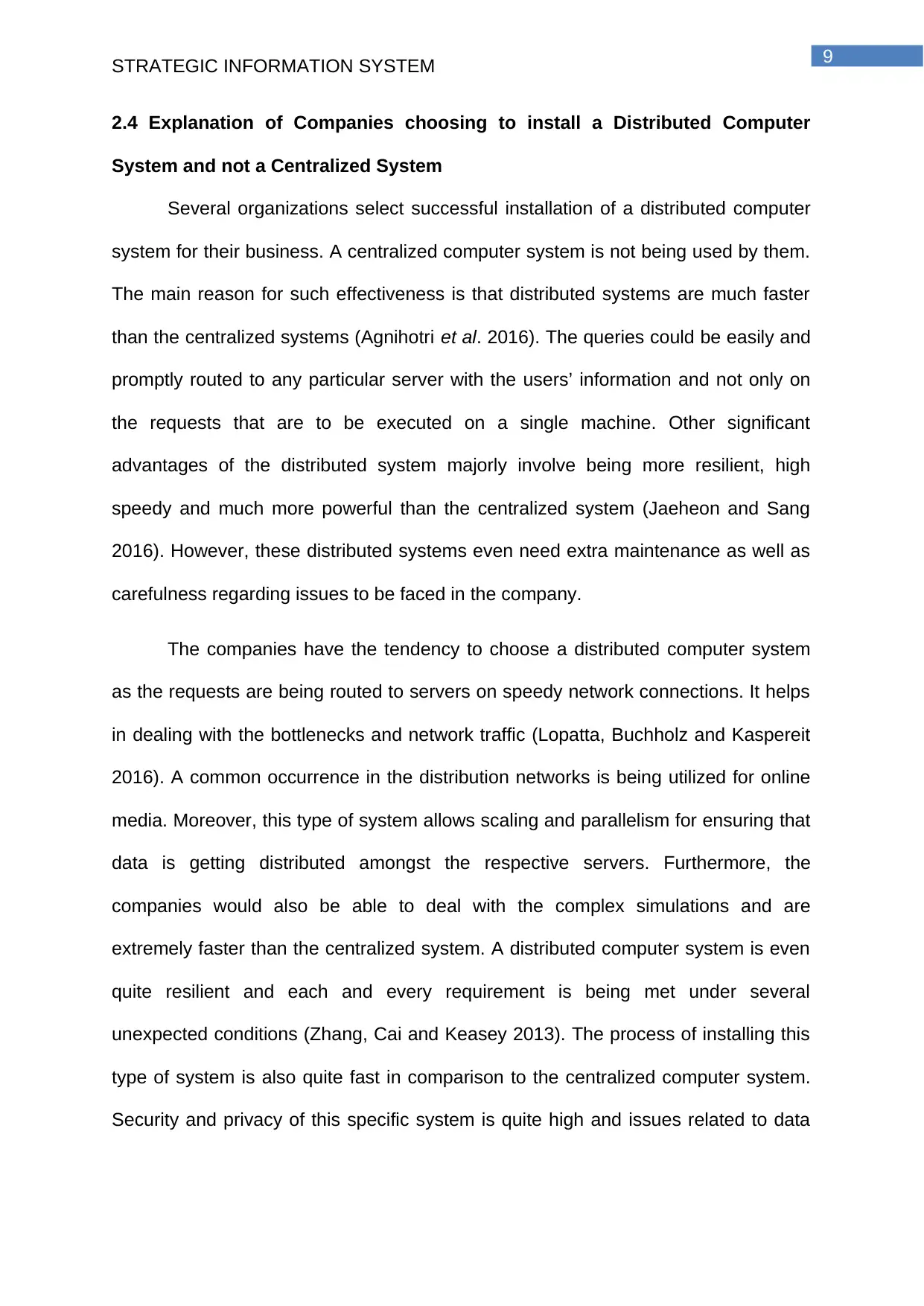
9
STRATEGIC INFORMATION SYSTEM
2.4 Explanation of Companies choosing to install a Distributed Computer
System and not a Centralized System
Several organizations select successful installation of a distributed computer
system for their business. A centralized computer system is not being used by them.
The main reason for such effectiveness is that distributed systems are much faster
than the centralized systems (Agnihotri et al. 2016). The queries could be easily and
promptly routed to any particular server with the users’ information and not only on
the requests that are to be executed on a single machine. Other significant
advantages of the distributed system majorly involve being more resilient, high
speedy and much more powerful than the centralized system (Jaeheon and Sang
2016). However, these distributed systems even need extra maintenance as well as
carefulness regarding issues to be faced in the company.
The companies have the tendency to choose a distributed computer system
as the requests are being routed to servers on speedy network connections. It helps
in dealing with the bottlenecks and network traffic (Lopatta, Buchholz and Kaspereit
2016). A common occurrence in the distribution networks is being utilized for online
media. Moreover, this type of system allows scaling and parallelism for ensuring that
data is getting distributed amongst the respective servers. Furthermore, the
companies would also be able to deal with the complex simulations and are
extremely faster than the centralized system. A distributed computer system is even
quite resilient and each and every requirement is being met under several
unexpected conditions (Zhang, Cai and Keasey 2013). The process of installing this
type of system is also quite fast in comparison to the centralized computer system.
Security and privacy of this specific system is quite high and issues related to data
STRATEGIC INFORMATION SYSTEM
2.4 Explanation of Companies choosing to install a Distributed Computer
System and not a Centralized System
Several organizations select successful installation of a distributed computer
system for their business. A centralized computer system is not being used by them.
The main reason for such effectiveness is that distributed systems are much faster
than the centralized systems (Agnihotri et al. 2016). The queries could be easily and
promptly routed to any particular server with the users’ information and not only on
the requests that are to be executed on a single machine. Other significant
advantages of the distributed system majorly involve being more resilient, high
speedy and much more powerful than the centralized system (Jaeheon and Sang
2016). However, these distributed systems even need extra maintenance as well as
carefulness regarding issues to be faced in the company.
The companies have the tendency to choose a distributed computer system
as the requests are being routed to servers on speedy network connections. It helps
in dealing with the bottlenecks and network traffic (Lopatta, Buchholz and Kaspereit
2016). A common occurrence in the distribution networks is being utilized for online
media. Moreover, this type of system allows scaling and parallelism for ensuring that
data is getting distributed amongst the respective servers. Furthermore, the
companies would also be able to deal with the complex simulations and are
extremely faster than the centralized system. A distributed computer system is even
quite resilient and each and every requirement is being met under several
unexpected conditions (Zhang, Cai and Keasey 2013). The process of installing this
type of system is also quite fast in comparison to the centralized computer system.
Security and privacy of this specific system is quite high and issues related to data
Secure Best Marks with AI Grader
Need help grading? Try our AI Grader for instant feedback on your assignments.
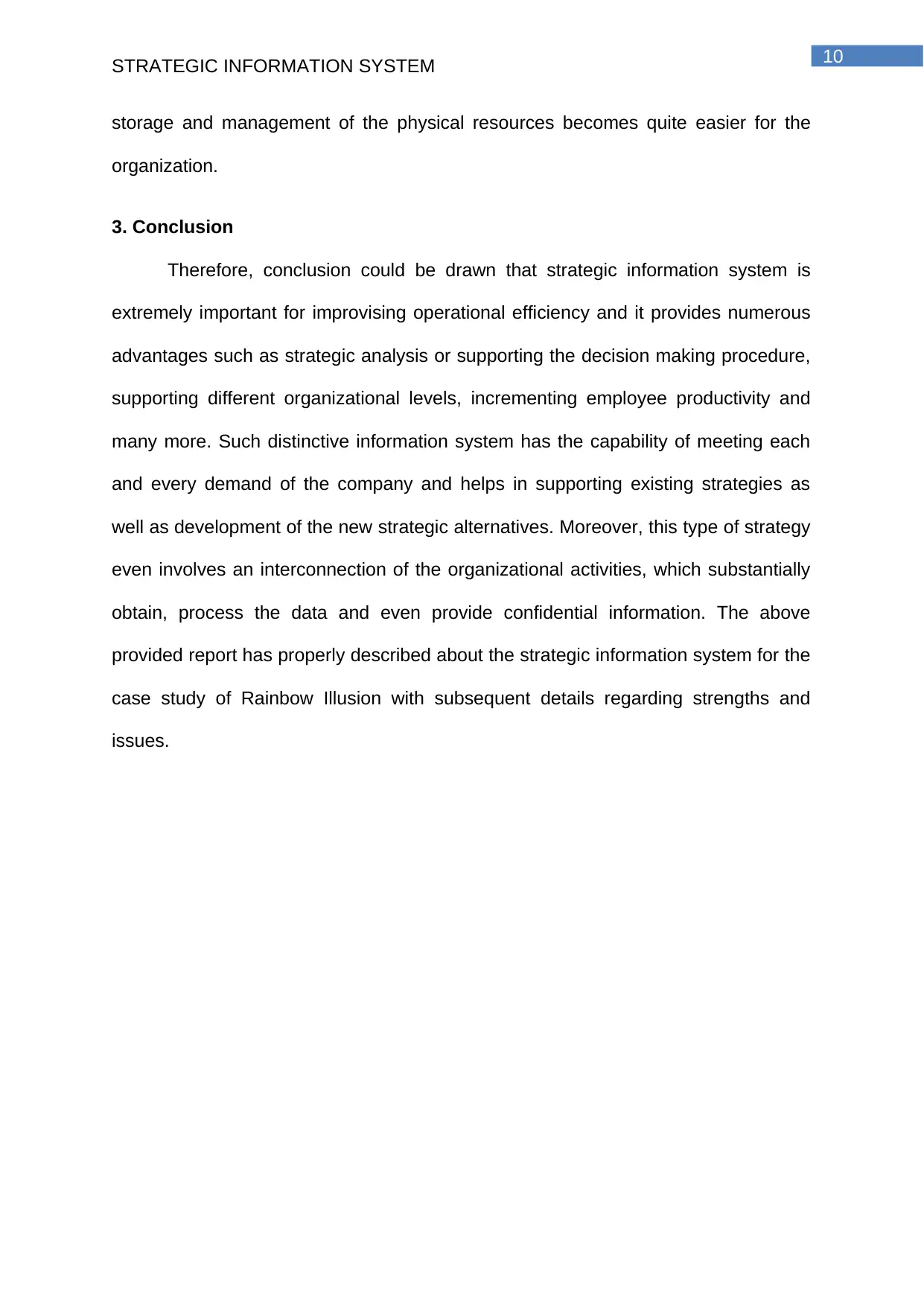
10
STRATEGIC INFORMATION SYSTEM
storage and management of the physical resources becomes quite easier for the
organization.
3. Conclusion
Therefore, conclusion could be drawn that strategic information system is
extremely important for improvising operational efficiency and it provides numerous
advantages such as strategic analysis or supporting the decision making procedure,
supporting different organizational levels, incrementing employee productivity and
many more. Such distinctive information system has the capability of meeting each
and every demand of the company and helps in supporting existing strategies as
well as development of the new strategic alternatives. Moreover, this type of strategy
even involves an interconnection of the organizational activities, which substantially
obtain, process the data and even provide confidential information. The above
provided report has properly described about the strategic information system for the
case study of Rainbow Illusion with subsequent details regarding strengths and
issues.
STRATEGIC INFORMATION SYSTEM
storage and management of the physical resources becomes quite easier for the
organization.
3. Conclusion
Therefore, conclusion could be drawn that strategic information system is
extremely important for improvising operational efficiency and it provides numerous
advantages such as strategic analysis or supporting the decision making procedure,
supporting different organizational levels, incrementing employee productivity and
many more. Such distinctive information system has the capability of meeting each
and every demand of the company and helps in supporting existing strategies as
well as development of the new strategic alternatives. Moreover, this type of strategy
even involves an interconnection of the organizational activities, which substantially
obtain, process the data and even provide confidential information. The above
provided report has properly described about the strategic information system for the
case study of Rainbow Illusion with subsequent details regarding strengths and
issues.
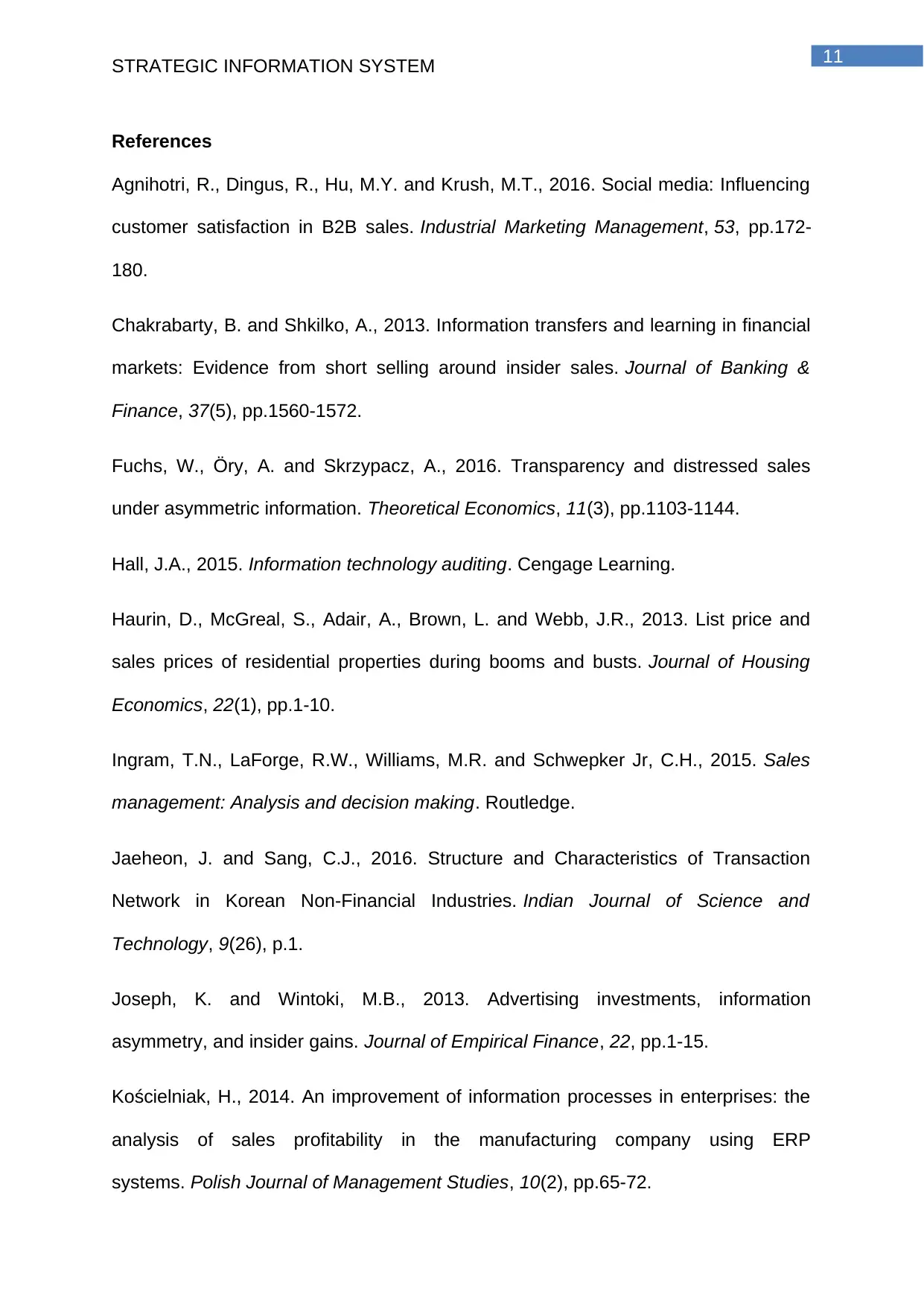
11
STRATEGIC INFORMATION SYSTEM
References
Agnihotri, R., Dingus, R., Hu, M.Y. and Krush, M.T., 2016. Social media: Influencing
customer satisfaction in B2B sales. Industrial Marketing Management, 53, pp.172-
180.
Chakrabarty, B. and Shkilko, A., 2013. Information transfers and learning in financial
markets: Evidence from short selling around insider sales. Journal of Banking &
Finance, 37(5), pp.1560-1572.
Fuchs, W., Öry, A. and Skrzypacz, A., 2016. Transparency and distressed sales
under asymmetric information. Theoretical Economics, 11(3), pp.1103-1144.
Hall, J.A., 2015. Information technology auditing. Cengage Learning.
Haurin, D., McGreal, S., Adair, A., Brown, L. and Webb, J.R., 2013. List price and
sales prices of residential properties during booms and busts. Journal of Housing
Economics, 22(1), pp.1-10.
Ingram, T.N., LaForge, R.W., Williams, M.R. and Schwepker Jr, C.H., 2015. Sales
management: Analysis and decision making. Routledge.
Jaeheon, J. and Sang, C.J., 2016. Structure and Characteristics of Transaction
Network in Korean Non-Financial Industries. Indian Journal of Science and
Technology, 9(26), p.1.
Joseph, K. and Wintoki, M.B., 2013. Advertising investments, information
asymmetry, and insider gains. Journal of Empirical Finance, 22, pp.1-15.
Kościelniak, H., 2014. An improvement of information processes in enterprises: the
analysis of sales profitability in the manufacturing company using ERP
systems. Polish Journal of Management Studies, 10(2), pp.65-72.
STRATEGIC INFORMATION SYSTEM
References
Agnihotri, R., Dingus, R., Hu, M.Y. and Krush, M.T., 2016. Social media: Influencing
customer satisfaction in B2B sales. Industrial Marketing Management, 53, pp.172-
180.
Chakrabarty, B. and Shkilko, A., 2013. Information transfers and learning in financial
markets: Evidence from short selling around insider sales. Journal of Banking &
Finance, 37(5), pp.1560-1572.
Fuchs, W., Öry, A. and Skrzypacz, A., 2016. Transparency and distressed sales
under asymmetric information. Theoretical Economics, 11(3), pp.1103-1144.
Hall, J.A., 2015. Information technology auditing. Cengage Learning.
Haurin, D., McGreal, S., Adair, A., Brown, L. and Webb, J.R., 2013. List price and
sales prices of residential properties during booms and busts. Journal of Housing
Economics, 22(1), pp.1-10.
Ingram, T.N., LaForge, R.W., Williams, M.R. and Schwepker Jr, C.H., 2015. Sales
management: Analysis and decision making. Routledge.
Jaeheon, J. and Sang, C.J., 2016. Structure and Characteristics of Transaction
Network in Korean Non-Financial Industries. Indian Journal of Science and
Technology, 9(26), p.1.
Joseph, K. and Wintoki, M.B., 2013. Advertising investments, information
asymmetry, and insider gains. Journal of Empirical Finance, 22, pp.1-15.
Kościelniak, H., 2014. An improvement of information processes in enterprises: the
analysis of sales profitability in the manufacturing company using ERP
systems. Polish Journal of Management Studies, 10(2), pp.65-72.
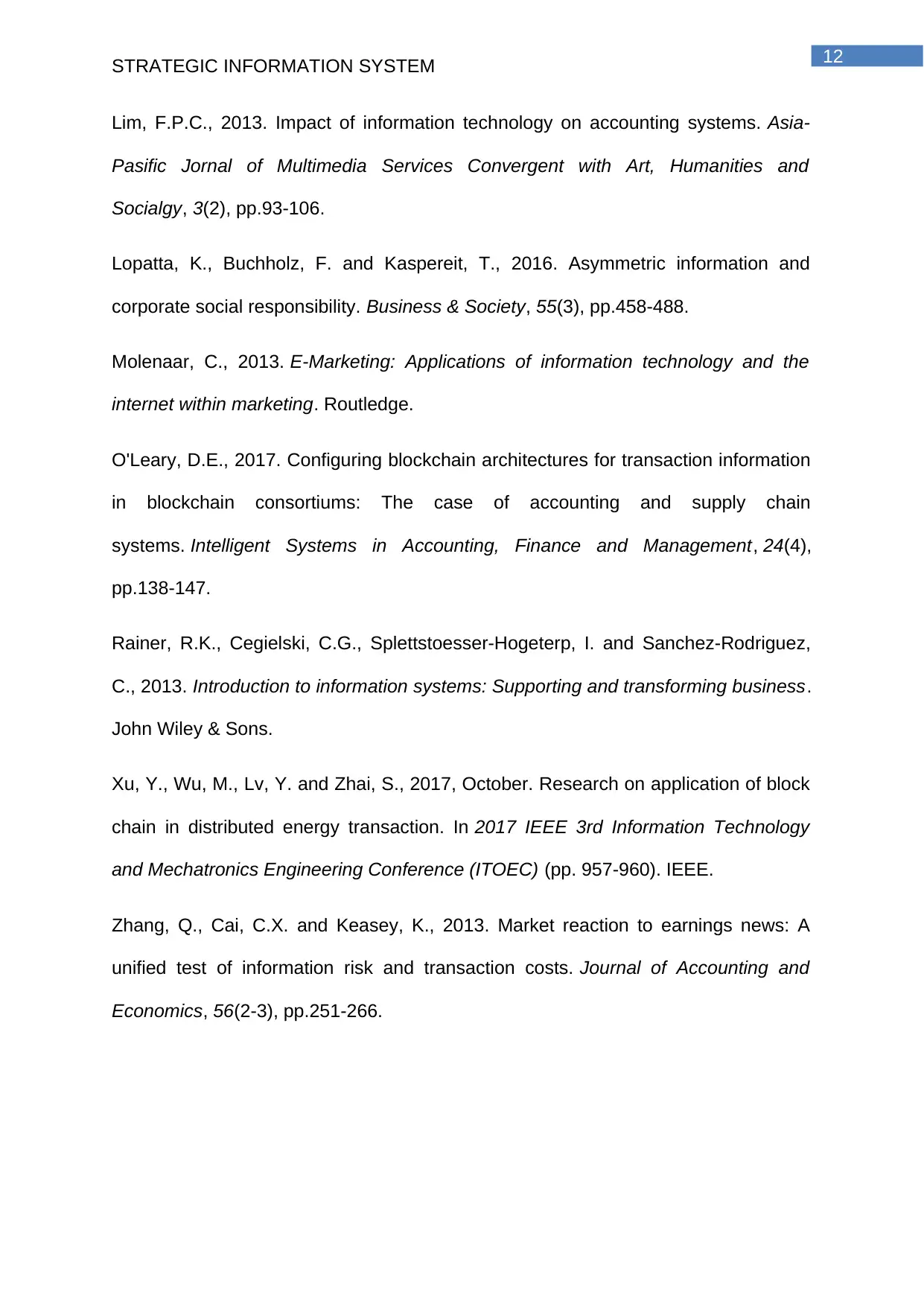
12
STRATEGIC INFORMATION SYSTEM
Lim, F.P.C., 2013. Impact of information technology on accounting systems. Asia-
Pasific Jornal of Multimedia Services Convergent with Art, Humanities and
Socialgy, 3(2), pp.93-106.
Lopatta, K., Buchholz, F. and Kaspereit, T., 2016. Asymmetric information and
corporate social responsibility. Business & Society, 55(3), pp.458-488.
Molenaar, C., 2013. E-Marketing: Applications of information technology and the
internet within marketing. Routledge.
O'Leary, D.E., 2017. Configuring blockchain architectures for transaction information
in blockchain consortiums: The case of accounting and supply chain
systems. Intelligent Systems in Accounting, Finance and Management, 24(4),
pp.138-147.
Rainer, R.K., Cegielski, C.G., Splettstoesser-Hogeterp, I. and Sanchez-Rodriguez,
C., 2013. Introduction to information systems: Supporting and transforming business.
John Wiley & Sons.
Xu, Y., Wu, M., Lv, Y. and Zhai, S., 2017, October. Research on application of block
chain in distributed energy transaction. In 2017 IEEE 3rd Information Technology
and Mechatronics Engineering Conference (ITOEC) (pp. 957-960). IEEE.
Zhang, Q., Cai, C.X. and Keasey, K., 2013. Market reaction to earnings news: A
unified test of information risk and transaction costs. Journal of Accounting and
Economics, 56(2-3), pp.251-266.
STRATEGIC INFORMATION SYSTEM
Lim, F.P.C., 2013. Impact of information technology on accounting systems. Asia-
Pasific Jornal of Multimedia Services Convergent with Art, Humanities and
Socialgy, 3(2), pp.93-106.
Lopatta, K., Buchholz, F. and Kaspereit, T., 2016. Asymmetric information and
corporate social responsibility. Business & Society, 55(3), pp.458-488.
Molenaar, C., 2013. E-Marketing: Applications of information technology and the
internet within marketing. Routledge.
O'Leary, D.E., 2017. Configuring blockchain architectures for transaction information
in blockchain consortiums: The case of accounting and supply chain
systems. Intelligent Systems in Accounting, Finance and Management, 24(4),
pp.138-147.
Rainer, R.K., Cegielski, C.G., Splettstoesser-Hogeterp, I. and Sanchez-Rodriguez,
C., 2013. Introduction to information systems: Supporting and transforming business.
John Wiley & Sons.
Xu, Y., Wu, M., Lv, Y. and Zhai, S., 2017, October. Research on application of block
chain in distributed energy transaction. In 2017 IEEE 3rd Information Technology
and Mechatronics Engineering Conference (ITOEC) (pp. 957-960). IEEE.
Zhang, Q., Cai, C.X. and Keasey, K., 2013. Market reaction to earnings news: A
unified test of information risk and transaction costs. Journal of Accounting and
Economics, 56(2-3), pp.251-266.
Paraphrase This Document
Need a fresh take? Get an instant paraphrase of this document with our AI Paraphraser
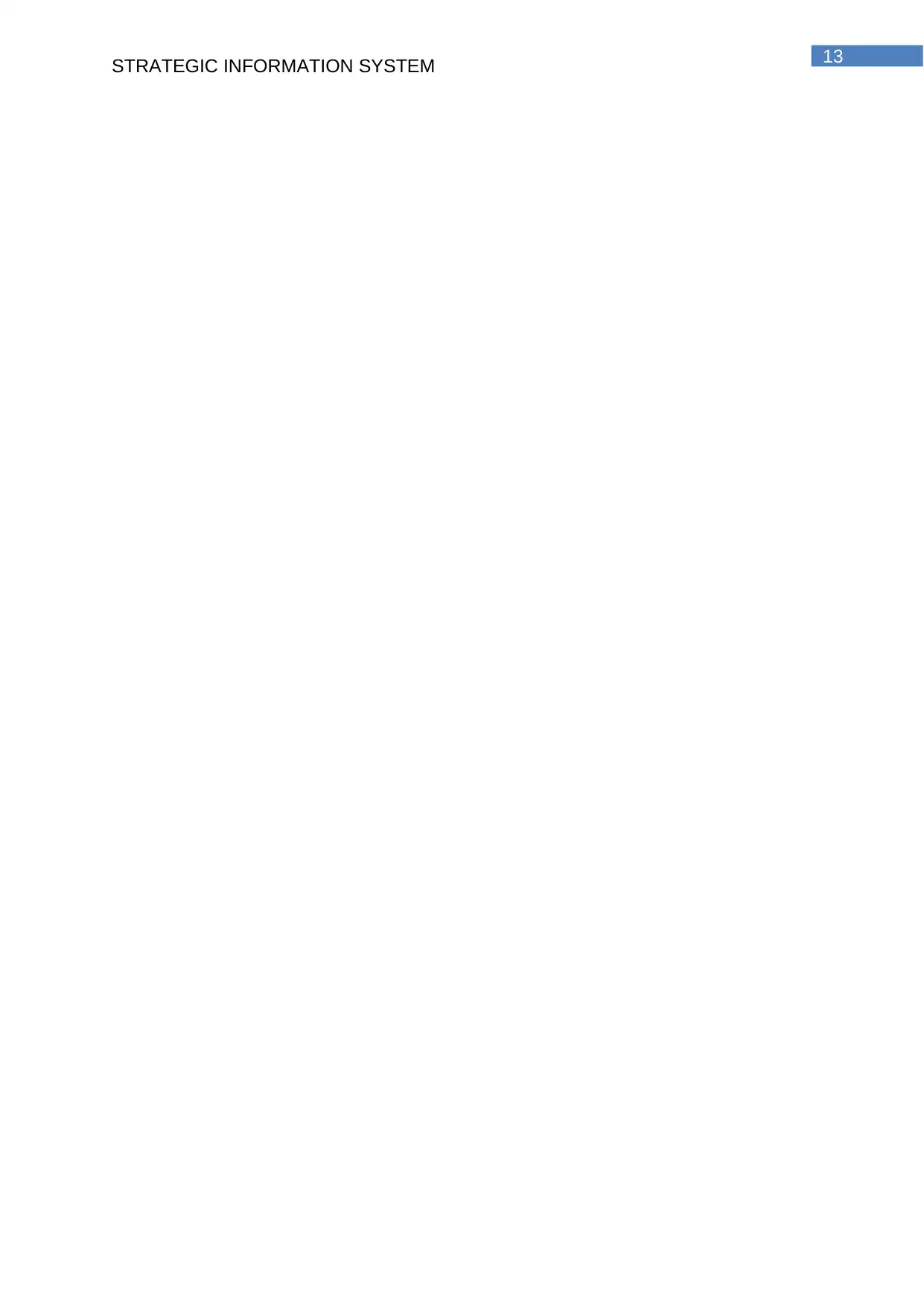
13
STRATEGIC INFORMATION SYSTEM
STRATEGIC INFORMATION SYSTEM
1 out of 14
Related Documents
Your All-in-One AI-Powered Toolkit for Academic Success.
+13062052269
info@desklib.com
Available 24*7 on WhatsApp / Email
![[object Object]](/_next/static/media/star-bottom.7253800d.svg)
Unlock your academic potential
© 2024 | Zucol Services PVT LTD | All rights reserved.





